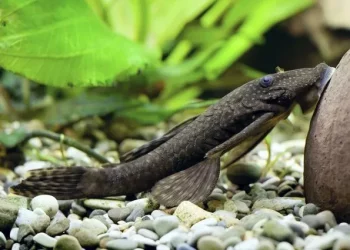The Australian lungfish, also known as the Queensland lungfish, is a fascinating and ancient species that has existed for over 100 million years. As a living fossil, it has evolved to become one of the most unique fish species in the world. One of the most interesting aspects of this species is its diet. In this article, we will discuss what the Australian lungfish eats and how its feeding habits contribute to its survival.
Overview of the Australian Lungfish
The Australian lungfish is a large freshwater fish that can grow up to 1.5 meters (5 feet) in length and weigh up to 40 kilograms (88 pounds). It is found in the rivers of eastern Australia, primarily in the Mary and Burnett River systems in Queensland.
The lungfish is unique in that it is an air-breathing fish, meaning it has the ability to breathe air through a primitive lung. This adaptation allows it to survive in stagnant or low-oxygenated water, as well as to survive droughts.
Diet of the Australian Lungfish
The Australian lungfish is primarily a herbivore, meaning it feeds on plants. Its diet consists of a variety of aquatic plants, including algae, water lilies, and other aquatic vegetation. They also consume small invertebrates such as insects and mollusks, which they filter from the substrate using their specialized teeth.
While the Australian lungfish is primarily a herbivore, it has been known to feed on small fish and crustaceans on occasion. These opportunistic feedings occur when the fish is in need of additional protein to supplement its primarily herbivorous diet.
Feeding Habits of the Australian Lungfish
The feeding habits of the Australian lungfish are unique and highly specialized. They are able to use their specialized teeth to grind and crush plant matter, which they then swallow whole. This grinding action helps to break down tough plant fibers, making the nutrients more accessible for digestion.
In addition to their unique feeding habits, the Australian lungfish is also known for its ability to aestivate, or enter a state of dormancy during droughts or other unfavorable conditions. During this time, the fish will reduce its metabolic rate and enter a period of prolonged inactivity. This allows the fish to conserve energy and survive until more favorable conditions return.
Conservation of the Australian Lungfish
The Australian lungfish is listed as a vulnerable species by the International Union for Conservation of Nature (IUCN) due to habitat loss and degradation, as well as overfishing. The species is protected under Australian law, and it is illegal to catch or harm them without a permit.
As the Australian lungfish is an important part of the freshwater ecosystem, it is crucial that steps are taken to protect its habitat and ensure its survival. This includes reducing pollution in waterways, conserving wetland habitats, and limiting the impact of human activity on the species.
In conclusion, the Australian lungfish is a fascinating and ancient species that has evolved to become one of the most unique fish species in the world. Its herbivorous diet and specialized feeding habits are essential to its survival, and it plays an important role in the freshwater ecosystem. As a vulnerable species, it is important that we take steps to protect its habitat and ensure its survival for future generations to enjoy.


























